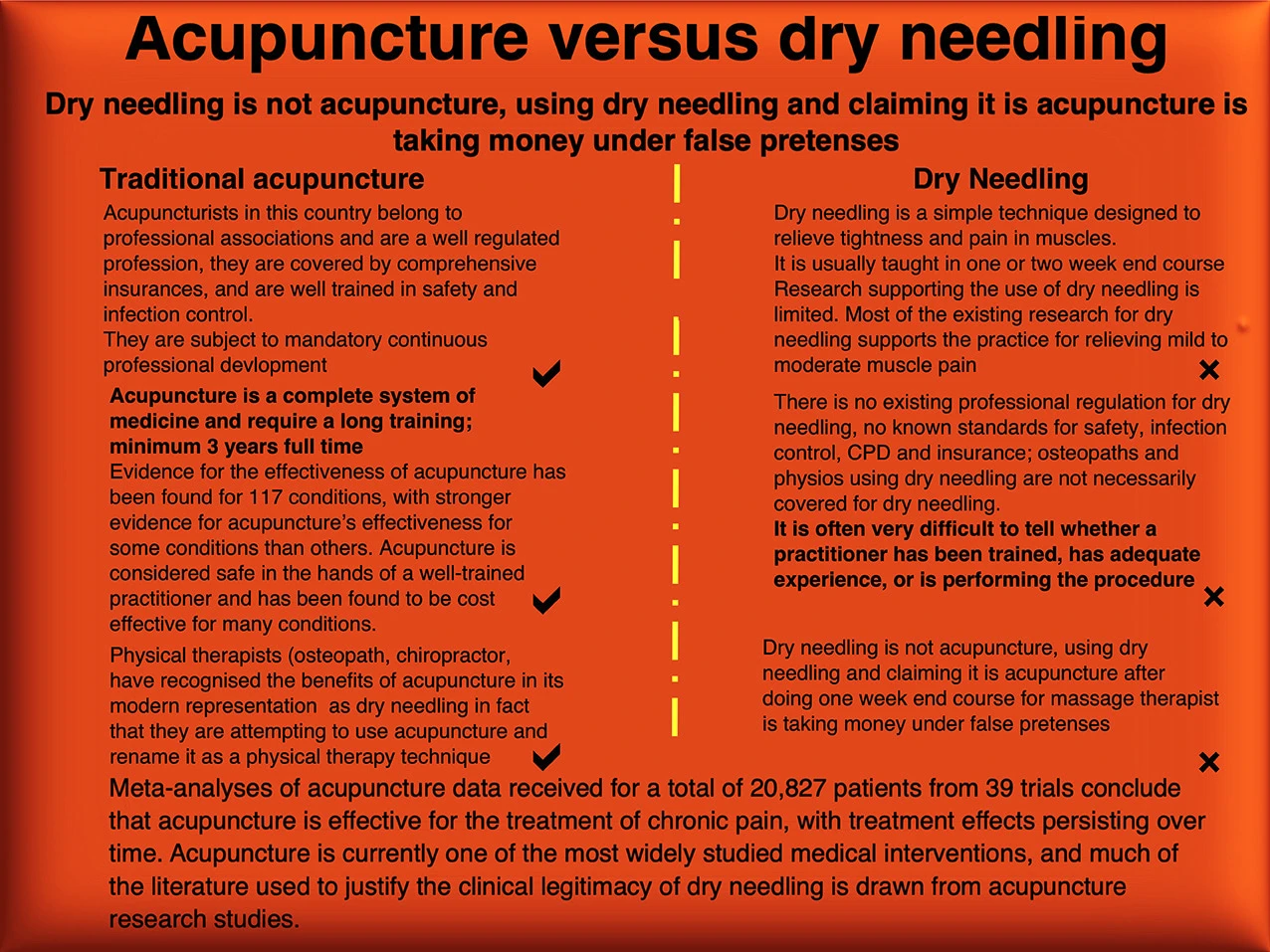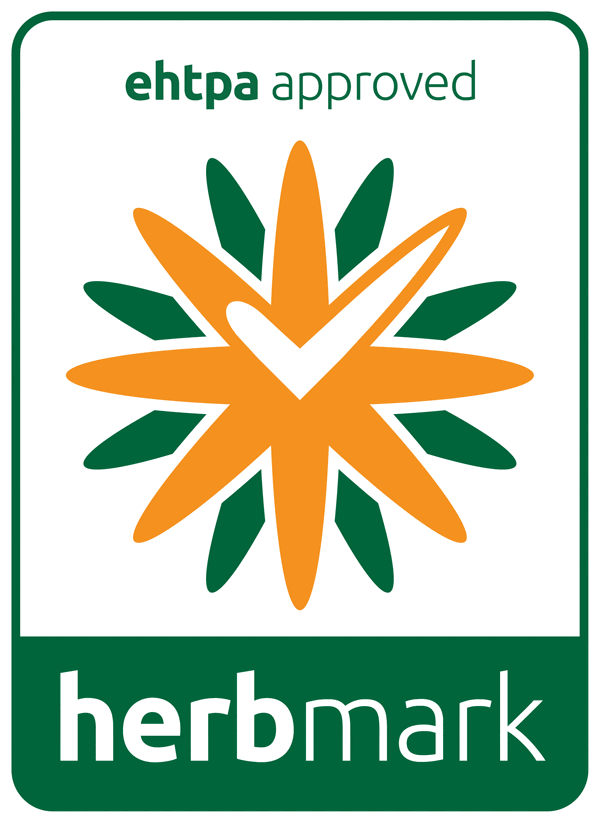What is the difference between acupuncture and dry needing?
Traditional acupuncture versus medical acupuncture


What is 'dry needling'?
The practice of ‘dry needling’ involves inserting an acupuncture needle into a trigger point and is typically used to treat the pain associated.
A trigger point is a tender spot in a tight band of muscle, which causes pain when pressed or squeezed.
A physiotherapist dry needling training program often runs for just a few days – 80 hours to be precise which is just enough time for people to gain a rudimentary understanding of how to ‘needle the point that hurts’ and provide short-term pain relief.
So is acupuncture the same as ‘dry needling’?
The increasing prevalence of the term ‘dry needling’ has created some confusion.
Acupuncture practice incorporates many different needling techniques and a variety of these may be required to gain the best results.
Dry needling, also known as trigger point acupuncture refers to just one of these techniques.
A Traditional acupuncturist is qualified in many techniques, including trigger point acupuncture, and will adopt the best approach depending on the patient’s individual needs.
The best approach does not rely on trigger points alone and sometimes trigger points are not necessary at all.
If you’re only having ‘dry needling’, you are missing out on most of what a traditional acupuncturist has to offer.
So do acupuncturists offer something more?
Absolutely.
There is much more to acupuncture than the insertion of needles into tender points.
Often the tender point will return if the underlying cause is not identified and addressed.
Quality acupuncture practice involves comprehensive patient assessment, an acupuncture diagnosis and an individualised treatment plan.
Appropriate needling methods and supplementary treatment can then be designed to match the patient’s circumstances.
Acupuncturists combine both a traditional understanding of the body from a Chinese medicine perspective with modern innovations from current research; so in addition to methods such as needling, cupping and moxibustion, acupuncturists may use exercise therapy, massage techniques or electro- or laser- stimulation of acupoints.
Some may also practice Chinese herbal medicine or other health modalities such as Western herbalism.
This comprehensive approach results in a holistic diagnosis and treatment plan.
The practice of ‘dry needling’ involves inserting an acupuncture needle into a trigger point and is typically used to treat the pain associated.
A trigger point is a tender spot in a tight band of muscle, which causes pain when pressed or squeezed.
A physiotherapist dry needling training program often runs for just a few days – 80 hours to be precise which is just enough time for people to gain a rudimentary understanding of how to ‘needle the point that hurts’ and provide short-term pain relief.
So is acupuncture the same as ‘dry needling’?
The increasing prevalence of the term ‘dry needling’ has created some confusion.
Acupuncture practice incorporates many different needling techniques and a variety of these may be required to gain the best results.
Dry needling, also known as trigger point acupuncture refers to just one of these techniques.
A Traditional acupuncturist is qualified in many techniques, including trigger point acupuncture, and will adopt the best approach depending on the patient’s individual needs.
The best approach does not rely on trigger points alone and sometimes trigger points are not necessary at all.
If you’re only having ‘dry needling’, you are missing out on most of what a traditional acupuncturist has to offer.
So do acupuncturists offer something more?
Absolutely.
There is much more to acupuncture than the insertion of needles into tender points.
Often the tender point will return if the underlying cause is not identified and addressed.
Quality acupuncture practice involves comprehensive patient assessment, an acupuncture diagnosis and an individualised treatment plan.
Appropriate needling methods and supplementary treatment can then be designed to match the patient’s circumstances.
Acupuncturists combine both a traditional understanding of the body from a Chinese medicine perspective with modern innovations from current research; so in addition to methods such as needling, cupping and moxibustion, acupuncturists may use exercise therapy, massage techniques or electro- or laser- stimulation of acupoints.
Some may also practice Chinese herbal medicine or other health modalities such as Western herbalism.
This comprehensive approach results in a holistic diagnosis and treatment plan.
Dry needling and acupuncture use the same equipment, but are based on completely different theoretical mechanisms .
An acupuncturist can do dry needing, but a "dry needler" cannot do acupuncture.
How does acupuncture differ from medical acupuncture?
These are two completely different therapies.
· Traditional acupuncture is a stand-alone system which uses diagnostic techniques and treatment methods based on the principles of oriental medicine. As well as relieving immediate symptoms, acupuncture addresses the underlying causes of illness and promotes ongoing physical health and emotional wellbeing. It restores the overall health of the person at the same time as treating their primary condition.
These are two completely different therapies.
· Traditional acupuncture is a stand-alone system which uses diagnostic techniques and treatment methods based on the principles of oriental medicine. As well as relieving immediate symptoms, acupuncture addresses the underlying causes of illness and promotes ongoing physical health and emotional wellbeing. It restores the overall health of the person at the same time as treating their primary condition.
- BAcC registered acupuncturists are trained to:
- Read subtle signs in the body to understand the precise cause of any collection of physical symptoms
- know relevant western medicine including anatomy, physiology, pharmacology, pathology and aetiology
- know the location and functions of 360+ acupuncture points on the body
- select the most appropriate points prescription for each individual patient
- treat both the underlying cause of an illness as well as relieve immediate physical symptoms
- recognise the ‘red flags’ that indicate cancer, cardio-vascular disease, diabetes and other life-threatening illnesses, and refer those patients to other healthcare practitioners for tests and treatment where appropriate.
Medical acupuncture is a recent development used by doctors, nurses, midwives, dentists, physiotherapists, osteopaths and chiropractors. Sometimes called ‘dry needling’, in this version of acupuncture a very small number of acupuncture points are used to relieve immediate physical symptoms. Dry needling is used as an adjunct to the main therapeutic technique and within the framework of a western medical diagnosis. Unlike traditional acupuncture it does not seek to regulate qi or address the underlying imbalance that caused the symptoms to arise.
Pj Cousin is a full member of the British Acupuncture Council and of the Unified Register of herbal Practitioners
Acupuncture at Cure by Nature
95 Replingham Road, London SW18 5LU
Tel: 07720773890
For a map Click here
Appointment available weekdays only
95 Replingham Road, London SW18 5LU
Tel: 07720773890
For a map Click here
Appointment available weekdays only
Traditional Chinese Medicine (TCM)
is one of the oldest and most mysterious form of health care, the first book on this subject is about 2500 years old, and there are indications that the Chinese were already using a crude form of TCM 4000 years ago.
Today, this medical system is widely used in China, Japan, Vietnam, Korea and all around Asia; in China alone there are 2500 hospitals specialising in TCM. This complex medical system is taught in 30 Chinese universities, to thousands of students from 120 different countries.
is one of the oldest and most mysterious form of health care, the first book on this subject is about 2500 years old, and there are indications that the Chinese were already using a crude form of TCM 4000 years ago.
Today, this medical system is widely used in China, Japan, Vietnam, Korea and all around Asia; in China alone there are 2500 hospitals specialising in TCM. This complex medical system is taught in 30 Chinese universities, to thousands of students from 120 different countries.
Acupuncture at Cure By Nature
95 Replingham Road
London SW18 5LU
tel: 020 88751101
For a map Click here
Appointment available Mondays, Tuesdays, Wednesdays and Fridays
95 Replingham Road
London SW18 5LU
tel: 020 88751101
For a map Click here
Appointment available Mondays, Tuesdays, Wednesdays and Fridays
Acupuncture London: fertility clinics of acupuncture and complementary medicine at 95 Replingham Road london SW18 5LU




